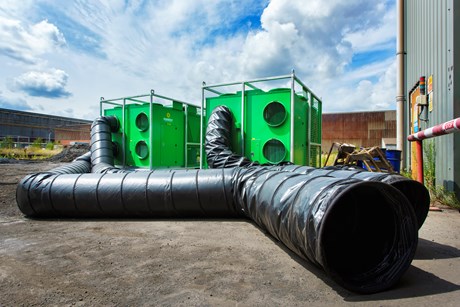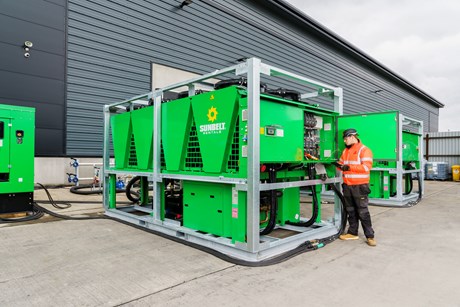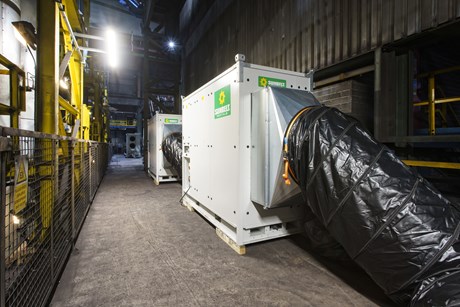What is HVAC and how does it work?
blog 30 Apr 2025
If you've ever adjusted a thermostat, enjoyed a cool breeze from an air vent, or stayed warm indoors during a winter storm, you've benefited from HVAC - even if you didn’t realise it!
Indoor environments like offices, warehouses, factories and public spaces all rely on these systems to stay comfortable, year-round. But HVAC isn't just about comfort; it also plays a crucial role in air quality, energy efficiency, and even overall health. HVAC is also crucial in temporary structures - events, film & TV productions and more.
In this guide, we’ll break down everything you need to know about HVAC systems - how they work, what components they include, and why they matter more than ever in today’s buildings.

What does HVAC stand for?
HVAC stands for Heating, Ventilation, and Air Conditioning. But it’s much more than just a simple acronym.
HVAC systems are essential for maintaining comfortable indoor environments, making sure that the temperature, humidity and air quality remain at optimal levels.
These systems are critical in a wide range of commercial, industrial, and production environments.
They’re tailored to meet specific temperature and climate needs in three key areas:
- Space: Making sure workspaces, storage areas, warehouses, factories and other indoor spaces stay at the right temperature and humidity.
- Production: Keeping environments at the right temperature to maintain product quality in industries like manufacturing and food production.
- Equipment: Protecting sensitive equipment like electronics and machinery from overheating or humidity damage.
HVAC systems can be deployed as part of planned maintenance, in response to unexpected breakdowns, or as supplementary support to existing infrastructure during periods of high demand or extreme conditions.
What are the components of HVAC systems?
HVAC systems can be really complex, and they’re often customised to meet the specific needs of the environment.
The actual components can be grouped into three main categories:
Main Central Plant (Core systems)
These are the heavy-duty units that do most of the heating or cooling work.
- Chillers: Used for cooling, particularly in larger buildings or industrial processes.
- Heat Pump Chillers: Versatile units that can provide either heating or cooling depending on what's needed.
- Boilers (LTHW – Low Temperature Hot Water): Used to produce hot water for heating applications, especially in industrial or commercial setups.

Service Plant (Support systems):
These systems help move air or heat around the building and manage the indoor environment.
- DX Units / Air-to-Air Heat Pumps: Compact, energy-efficient units that can both heat and cool spaces.
- Air Handling Units (AHUs): Help circulate air, filter it, and keep the climate consistent across different areas.
- Heat Exchangers: Transfer heat between fluids without mixing them, helping boost overall energy efficiency.

Ancillaries (Supporting equipment):
These components support the system and help it run smoothly and safely.
- Fluid Pumps: Keep water or fluid moving through the system.
- Automated Valves: Control how much fluid or air flows through different parts of the system.
- Buffer & Expansion Vessels: Absorb pressure changes to keep things stable and running efficiently.
- Hoses & Ducting: Carry air or fluid between equipment and indoor spaces.
- Thermostats & Controls: Monitor conditions and adjust settings automatically to meet your target temperature or humidity.
A bespoke HVAC setup will usually include a selection of components from each group, designed around the specific performance, space, and environmental requirements of the job.
How do HVAC systems work?
To maintain a stable indoor climate, HVAC systems follow several key principles.
- Set Points and Feedback Loops: First, an integrated thermostat sets a target temperature (the "set point") based on the customers’ parameters. The system then monitors indoor conditions to adjust the heating or cooling output accordingly. This feedback loop helps to keep the temperature stable. In many buildings, different areas might have their own local controls, time clocks, or zoned settings, so each space gets exactly what it needs.
- Airflow Management: Air must be evenly distributed to avoid hot or cold spots. This is managed through ductwork and strategic placement of vents.
- Zoning: In larger buildings, different zones may require different temperature settings. Zoned temperature control allows for this flexibility, making sure different areas are conditioned appropriately.
What are the benefits of an efficient HVAC system?
A well-designed HVAC system doesn’t just keep your environment comfortable—it also supports sustainability and cost control.
When properly designed and installed, they can…
- Save money
- Break down less often
- Improve employee comfort
- Boost productivity
- Enhance visitor experiences
What factors affect HVAC performance?
Although HVAC systems are powerful and can deliver impressive results, they can be affected by a number of different factors.
Outdoor vs. indoor temperatures
Put simply, if the outdoor temperature is -10 °C and the target indoor temperature is 20°C, the system will need to work harder to bridge that gap - meaning it can take longer, and use more energy, to reach its goal.
Insulation and building envelope
Poor insulation or drafty areas often mean the system needs to work harder to maintain consistent climates throughout a space.
Incorrect setup
HVAC systems must match the specific needs of the space they serve - but those needs can change over time. As site usage evolves - whether due to new equipment, increased footfall, layout changes, or different processes - the original design parameters may no longer apply. If the system isn’t adjusted to reflect these new demands, it can lead to inefficient operation, increased energy use, and reduced performance. This is why every HVAC solution should be reviewed regularly and designed on a case-by-case basis, with flexibility in mind.
Equipment maintenance
The upkeep of HVAC equipment is also crucial. If the filter isn’t in tip-top condition, the equipment hasn’t been regularly serviced and maintained, or the ductwork restricts airflow - the throughput of temperature-controlled air can be inhibited, which leads to poor results.
Frequent manual adjustments
Finally, frequent manual adjustments or extreme set points of the thermostat can cause excessive cycling, which reduces the efficiency of the system, increases wear and means greater fuel burn. Systems are commissioned to meet the design data for the applications, so adjustments should always be reviewed and made by an expert.
It’s important to keep all these factors in mind in making sure a HVAC system works as efficiently and effectively as possible.
Future trends in HVAC technology: What’s next?! 🔮
The HVAC industry is constantly evolving, with new technologies creating smarter, more efficient systems for users.
One major development is the integration of HVAC systems with the Internet of Things (IoT), which allows systems to be controlled remotely.
These smart systems can also connect directly with Building Automation Systems (BAS). Often described as the "brain" of a smart building, a BAS allows engineers to monitor and manage one building, multiple sites, or even individual spaces from a single control hub. This centralised approach makes managing HVAC systems easier and much more efficient.
Artificial intelligence (AI) is also playing a growing role. AI can support remote monitoring, spot potential issues before they become problems, and let you know when maintenance is needed. This proactive approach helps reduce downtime, extend the life of equipment, and maintain a comfortable environment at all times.
Wrapping up
HVAC systems play a crucial role in maintaining optimal conditions for people, processes and equipment across a wide range of environments.
Understanding how these systems work is key to enhancing your spaces - whether you’re managing a commercial facility or planning a temporary solution – and that’s where we come in.
With a comprehensive fleet of HVAC equipment, backed by a team of experts, we’re trusted nationwide to deliver complex, bespoke solutions across all industry sectors.
Ready to kick off your next HVAC project? Speak to one of our experts today and explore our full range of equipment and services: Temperature Control | Sunbelt Rentals.

 Open your account online within 24 hours
Open your account online within 24 hours  Nationwide, next day delivery available
Nationwide, next day delivery available  Over 200 locations near you
Over 200 locations near you